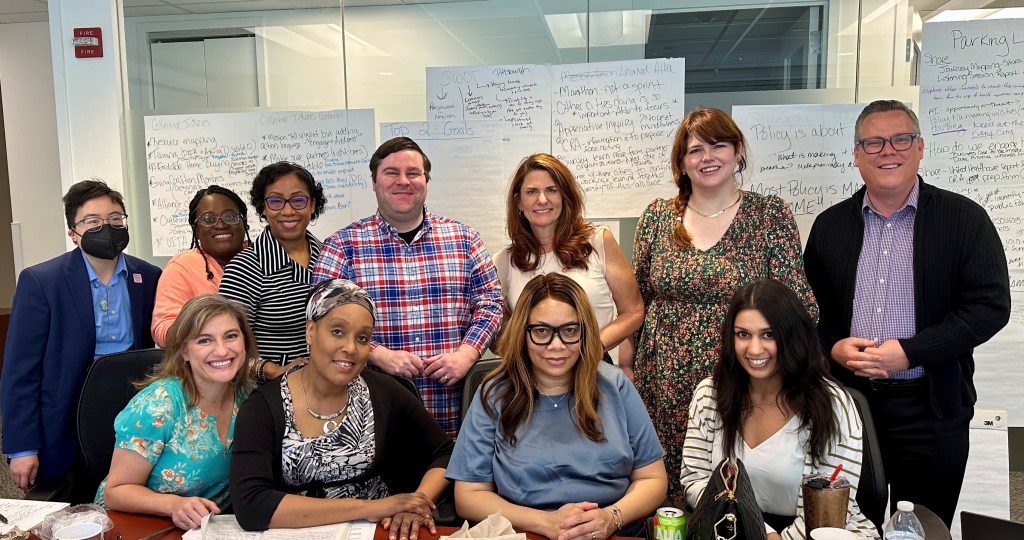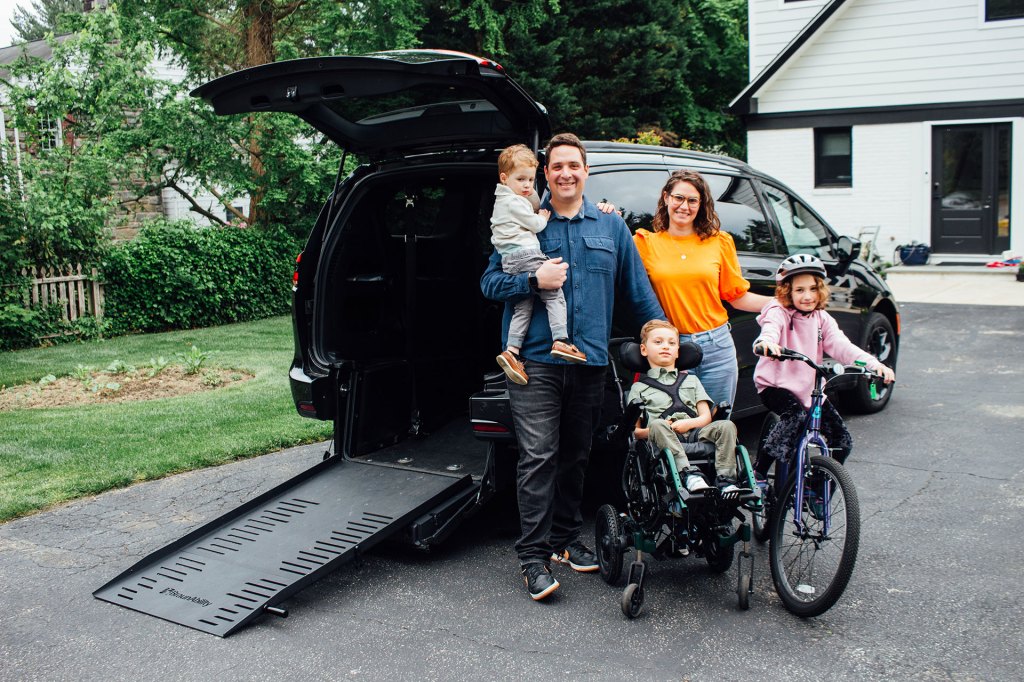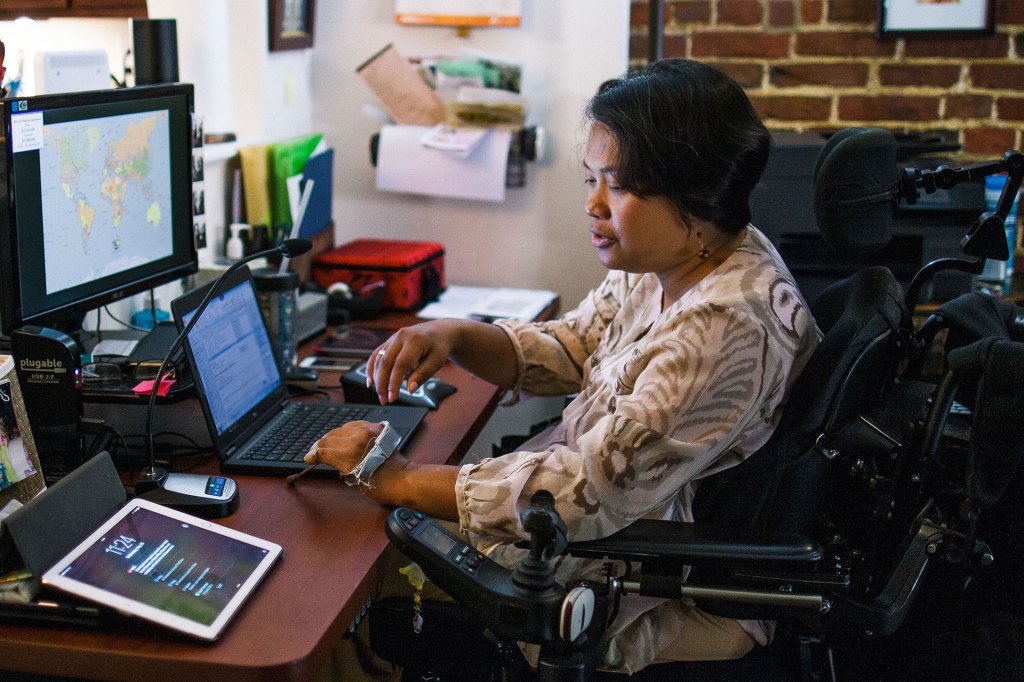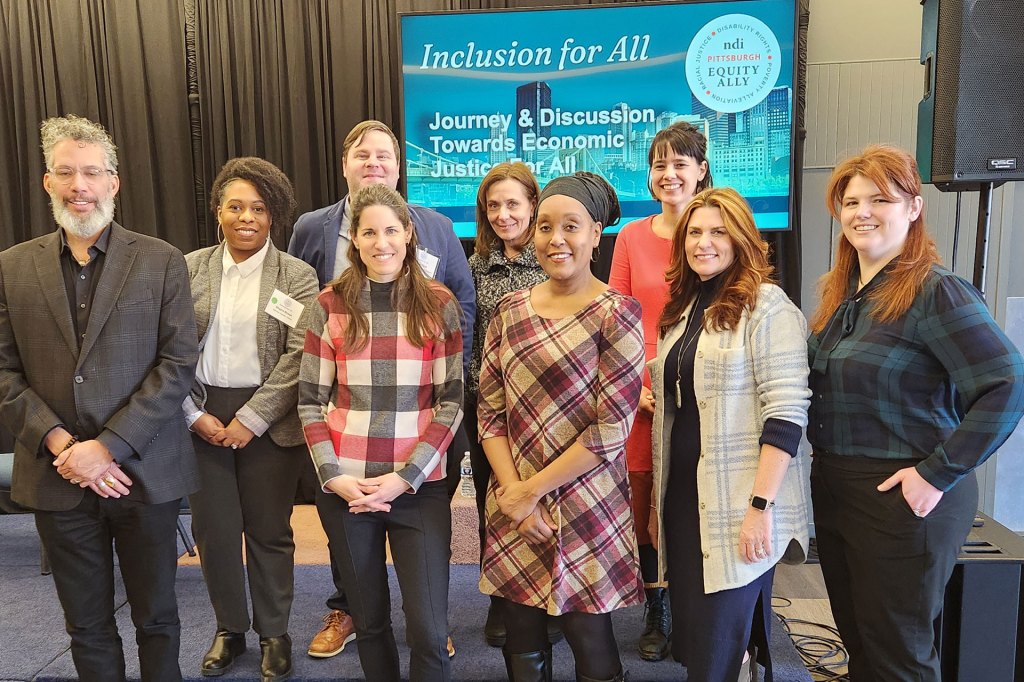National Disability Institute and city partners push for an inclusive economy accessible to all
People with disabilities are more likely to be unbanked and underemployed. The National Disability Institute has a plan and the right partners—including the Cleveland Fed—to change this pattern and make the economy more accessible for everyone.
By
, Fed Communities

Photo courtesy of NDI
In Pittsburgh, PA last March, Shajira Brown listened closely as a community member described the dilemma they recently faced applying for a job. Considering the boxes on the application they could check to indicate their race and disability, the community member hesitated. To this job applicant, Brown explained, disclosing both felt like a liability.
“They were choosing between whether to accurately share what race they were or disclosing their disability,” said Brown, director of equity and inclusion at the National Disability Institute (NDI).
More than 30 percent of households with a disability have to make ends meet with an annual household income under $15,000, compared with just over five percent of households without a disability.
“People hide their disabilities out of fear of being judged or let go,” she explained. “No one should fear or have to choose which part of their identity they share with others. It shouldn’t have any bearing on anything.”
But Brown and her colleagues regularly hear that there are in fact significant, detrimental financial impacts of living with a disability in the US. Grappling with systems and stereotypes that make it hard for them to access banking services or get a secure job with benefits, people with disabilities fall behind economically. And for people of color with disabilities, systemic barriers multiply.

“People hide their disabilities out of fear of being judged or let go. No one should fear or have to choose which part of their identity they share with others. It shouldn’t have any bearing on anything.“
– Shajira Brown, Director of Equity and Inclusion, National Disability Institute
Identifying the economic barriers facing people with disabilities
As the first national organization specifically committed to championing economic empowerment for people with disabilities and their families, NDI wants to change that. Society can benefit from these individuals’ contributions, but only if the systems involved make it possible for people with disabilities to equally participate.
NDI seeks to lay out a path forward to a fairer, more inclusive economic experience for people with disabilities in cities across the country. To get there, NDI has joined with community, financial, and governmental institutions—including the Cleveland Fed—and representatives of the disability community.
Over the past five years, NDI and its Alliance for Assets partners in three cities—Pittsburgh, Houston, and Detroit—have examined the factors economically limiting people with disabilities. Together, they’re discovering their individual roles in changing the systems people with disabilities must navigate.
“For us and many of the other partners, once we saw these economic barriers around disability and how they intersect with race and ethnicity, it was so hard to unsee it,” said Drew Pack, regional outreach manager at the Cleveland Fed’s Pittsburgh branch. “NDI is taking us to the next level of financial inclusion and empowerment.”

“For us and many of the other partners, once we saw these economic barriers around disability and how they intersect with race and ethnicity, it was so hard to unsee it. NDI is taking us to the next level of financial inclusion and empowerment.“
– Drew Pack, Regional Outreach Manager, Federal Reserve Bank of Cleveland
The added cost of living with a disability
According to the Americans with Disabilities Act, a person with a disability is anyone with a physical or mental impairment that substantially limits one or more life activities. There were more than 38 million Americans over age 18 with disabilities in 2022, per the US Census. They are people of all ages, genders, and racial and ethnic backgrounds. Anyone can become disabled at any time.
One thing this diverse group of people shares: It’s more expensive to have a disability. In part, this expense stems from the cost of assistive technology, mobility aids, medical assistance and drugs, and caregiving services that people with disabilities rely on to get by in everyday life.
A 2020 study found that at the median US household income level—in 2020, that was about $67,000—a household with a disability needed 28 percent more, or an additional $17,690, of income on average per year to experience the same standard of living as a household without a disability.
Especially for those whose disability limits their ability to work, having a disability may come with significant financial instability. More than 30 percent of households with a disability have to make ends meet with an annual household income under $15,000, compared with just over five percent of households without a disability.
People with disabilities face additional barriers accessing credit and can end up unbanked. Unbanked households are those in which no one has a checking or savings account with a bank or credit union. Households with a disability are more than four times likelier to be unbanked than households without a disability.

Photo courtesy of PATF
NDI and Syracuse University both recently surveyed people with disabilities to better understand why so many are unbanked. Some respondents explained that bank locations could be physically inaccessible, despite ADA requirements. Others noted that they felt so judged or dismissed by the way some bank staff responded to their disability that they did not want to bank there.
Some respondents also worried about overdraft fees or said they simply did not have enough money to open an account with a bank. Without adequate access to bank credit, people with disabilities are also more likely to rely on expensive nonbank credit options, including payday loans, pawn shops, or rent-to-own services.
Worse economic impacts for people of color with disabilities
In their work, NDI emphasizes how the combination of systemic racial, ethnic, and disability discrimination effects can worsen the challenges of poverty.
“We looked at the intersectionality of disability with race and ethnicity before anybody else was talking about it,” said Katie Metz, director of NDI’s Financial Resilience Center.
NDI’s research shows that households of color with a disability experience even more detrimental financial impact than white households with a disability. For example, a greater proportion of Black (44.3%) and Latino (31.7%) households with disabilities have incomes below $15,000 per year than white (25.6%) households with disabilities.
The percentage of unbanked Black households with disabilities is 2.6 times higher than for white households with disabilities. For Latino households with disabilities, the unbanked rate is twice as high as that of comparable white households.
Barriers to work and benefits
Some people with disabilities may qualify for Social Security Disability Insurance (DI), which provides monthly payments to help cover costs of living. To be eligible for DI, a person must have a disability that limits their ability work at all or beyond a limited number of hours.
Even among those who meet this definition, many struggle to get DI. During a months-long qualification process, most applicants cannot work and must jump through many hoops to provide proof of their disability. Nearly two-thirds of those who apply for DI ultimately are denied.
Many people with disabilities can and want to work, though, if provided access to needed accommodations around their disability. But as in Brown’s example from the Pittsburgh Alliance listening session, some are reluctant to disclose those needs, fearing they won’t be hired. Experts say that employers may believe mistakenly that disability accommodation costs will be prohibitive.
“One of the biggest misconceptions about people with disabilities is that they’ll need a lot of support if they’re hired,” said NDI’s Brown. “When support or accessibility accommodations are provided, the cost for accommodations is relatively low.”
For example, more than half of the employers who responded to a 2022 Department of Labor and Job Accommodation Network survey reported that there was no cost involved to accommodate the needs of their employees with disabilities. Thirty-seven percent said there was only a one-time cost to accommodate an employee with a disability, which amounted to a median expense of $300.

Photo courtesy of PATF
Never miss a story.
Diverse sectors join together to work on disability, race, and financial inclusion issues
To address the collective economic challenges people with disabilities face, NDI and its partners in the Alliances for Assets say representatives of all the systems involved need to be at the table. That includes community service providers, financial institutions, government agencies, employers, and people with disabilities.
The alliances’ work grew out of an initial summit in Pittsburgh in November of 2019, when NDI and JP Morgan Chase convened community leaders to discuss improving credit access for people with disabilities. Despite Covid-19 soon keeping them from meeting in person, alliances formed in the three cities and grew their work over the following years through virtual meetings.
The roundtables in Pittsburgh, Houston, and Detroit have also all met together in Washington, DC to share what they’ve learned and connect their work. They share the mission of figuring out how to address the systemic financial challenges that people with disabilities in communities of color face as a result of their intersecting identities.
NDI’s Metz said the growth and success of the collaboration depended heavily on the commitment of the diverse group of local organizations involved. Each does work that touches the disability community, communities of color, or low-income communities in some way, but their organizations did not necessarily work together before these coalitions formed.
“I’m blown away that all these leaders with other jobs to do, none with this specific mission, have taken on the local responsibility of continuing this work,” Metz said. “They’re saying, ‘We’re going to take on this extra work together because we now see that this intersectional effort around disability is our work.’”

“I’m blown away that all these leaders with other jobs to do, none with this specific mission, have taken on the local responsibility of continuing this work. They’re saying, ‘We’re going to take on this extra work together because we now see that this intersectional effort around disability is our work.“
– Katie Metz, Director, Financial Resilience Center, National Disability Institute
The Fed’s role in disability-inclusive financial access and empowerment
Pack of the Cleveland Fed spoke at the 2019 summit and has been an integral player in the Pittsburgh effort since. The Cleveland Fed participated in subsequent leadership roundtables and community listening sessions and plays a key role in the ongoing work developing out of the Pittsburgh alliance, which now includes more than 120 organizations.
“The Federal Reserve sitting at the table shows these individual organizations that the conversation is important,” said NDI’s Metz. “I think that’s extremely valuable, that the Fed is paying attention to what the community cares about.”
The Fed’s role as one of three agencies supervising financial institutions also matters to the alliances’ efforts to increase financial inclusion.
Financial institutions working to improve credit access and reduce barriers for people with disabilities may potentially qualify for Community Reinvestment Act (CRA) credit for that work. The CRA encourages banks across the US to help meet the credit needs of their entire communities. NDI’s Center for Disability-Inclusive Community Development helps community organizations and banks identify these CRA opportunities related to disability and financial inclusion.
One way banks may qualify for CRA credit is to support or work in partnership with local community development financial institutions (CDFIs), which are mission-oriented lenders. Pack noted, for example, the Pennsylvania Assistive Technology Foundation, a member of the Pittsburgh Alliance for Assets group and a CDFI that connects people with disabilities with needed assistive technology devices and services.
Pack also sees the Fed’s being part of the conversation around disability and financial inclusion through the alliances as integral to the Federal Reserve’s dual mandate. “It goes back to our mission of maximum employment and people being able to engage in the economy and have economic opportunity,” Pack said.
He added that it was enlightening and essential to hear from people with disabilities and caregivers in the Pittsburgh Alliance about where and how they have experienced pain points navigating local systems. “We’ve got to hear from people living this,” said Pack. “We are not going to do something without listening to people first.”

Photo courtesy of Drew Pack
Growing the partnership
Moving forward, the three city alliances are committed to continuing their local partnership work, with NDI providing guidance on their future goals. With the founding alliances now operating more independently, NDI turns its focus to creating toolkits and trainings for other cities. The partners hope that their three-city effort is just the beginning of a national movement toward financial inclusion and economic opportunity for diverse communities with disabilities.
“People with disabilities are educated, skilled, reliable leaders and have the same potential and drive as their counterparts,” NDI’s Brown said.
“Being employed and having access to credit will enable them to save money, acquire assets, and attain the same level of financial freedom as everyone else,” she added. “They deserve the opportunity to lead meaningful lives and support their families.”






